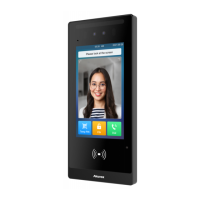
Do you have a question about the Akuvox E18C and is the answer not in the manual?
| Display | 7-inch capacitive touch screen |
|---|---|
| Resolution | 1024 x 600 |
| Audio | Built-in microphone and speaker |
| Operating System | Android |
| Processor | Quad-core |
| RAM | 2GB |
| Storage | 8GB |
| Ethernet | 10/100 Mbps |
| Operating Temperature | -10°C to 50°C |
| Ingress Protection | IP65 |
| Installation | Wall-mounted |
| Communication Protocol | SIP |
| Network | Wi-Fi |
| Power Supply | PoE or DC 12V |
Explains different configuration modes like Discovery, SmartPlus, and SDMC.
Lists configuration tools like SDMC, Upgrade tool, PC Manager, IP scanner, FacePro.
Details how to access and configure device settings directly on the device.
Explains accessing and configuring device settings via the web browser interface.
Covers how to set the device's display language.
Details how to configure time zone, date, and time format.
Covers LED settings for card reader and white light.
Explains adjustment of LCD screen brightness.
Details customization of screen displays and screensavers.
Covers adjustment of various volume levels and tone settings.
Covers configuring DHCP and static IP network connections.
Explains setting up LTE (4G) wireless network connectivity.
Details configuring RTP ports for network data transmission.
Covers configuring device location, mode, address, and extension numbers.
Explains Network Address Translation settings for SIP server connectivity.
Explains making and configuring IP calls.
Covers setting up SIP accounts and servers for calls.
Details fast dialing options and number replacement.
Covers enabling automatic answering of incoming calls.
Contains settings for maximum call duration and dial time.
Explains DTMF configuration for door access and third-party integration.
Details how to unlock the door via DTMF code using relays.
Explains configuring DTMF codes for door access and intercom synchronization.
Covers controlling door access using network-based web relays.
Explains setting up schedules for relays to keep doors open.
Covers creating and managing user-based door access schedules.
Explains creating daily, weekly, and longer period schedules via web.
Details how to create door access schedules directly on the device.
Covers importing and exporting schedules for efficient management.
Explains editing or deleting configured door access schedules.
Covers creating and modifying public and private PIN codes.
Details adding and configuring RF cards for user door unlock.
Explains configuring facial recognition for door access.
Covers batch configuration using all-in-one door access files.
Explains searching and editing user-specific door access data.
Covers enabling and using QR codes for door unlock.
Details using mobile phone Bluetooth for door access.
Covers using mobile phone NFC for door access.
Explains unlocking remotely via HTTP commands.
Details configuring the device's input to trigger relay via exit button.
Covers quick door unlock using the Reception tab.
Explains optional body temperature measurement for door access.
Covers setting up tamper alarm for device removal protection.
Explains SRTP voice encryption for secure communication.
Details enabling motion detection for surveillance and alarms.
Covers configuring security notifications via email, FTP, TFTP, or SIP call.
Explains setting the automatic log-out timing for the web interface.
Covers capturing MJPEG format monitoring images.
Explains how to view real-time video from the device.
Details enabling and configuring RTSP streams for audio/video monitoring.
Covers configuring ONVIF for video stream access by third-party devices.
Covers checking and exporting call history records.
Details checking and exporting door access history logs.
Explains checking and exporting temperature logs.
Covers exporting various log types.
Covers enabling and exporting system logs for debugging purposes.
Explains capturing data packets for debugging and troubleshooting.
Details configuring the User Agent string in SIP messages.
Explains general and MAC-based configuration files for auto-provisioning.
Details setting up automatic provisioning schedules.
Explains Plug and Play (PNP) configuration for adaptive hardware recognition.
Covers obtaining auto-provisioning URLs via DHCP options.
Explains manually setting server URLs for firmware and configuration downloads.
Details integrating with third-party devices using the Wiegand interface.
Explains integrating with devices via the RS485 interface.
Covers OSDP settings for access control communications.
Details integrating with third-party devices using the HTTP API.
Explains using the device as a power supply for external relays.
Covers restarting the device and setting up reboot schedules.
Details resetting the device to factory default settings.